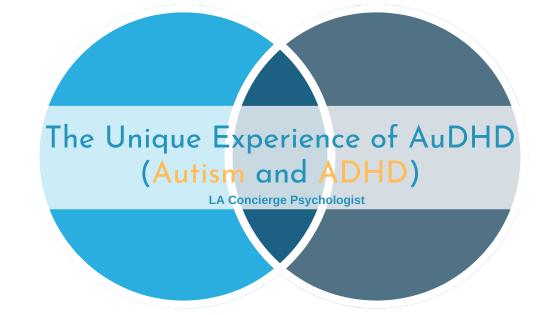Many people assume that ADHD involves a total deficit of attention. That assumption is reasonable since the term “attention deficit” is right there in the disorder’s name. The American Psychiatric Association describes ADHD as an inability to “give close attention.” If you observe someone with ADHD as they attempt to sit still in class or complete their chores, this definition will probably seem accurate.
However, if you observe someone with ADHD while they are enjoying their favorite hobby, you can see that they actually have plenty of attention to give. They can hold their attention on an exciting task for hours on end—often to the exclusion of all else. Yet, many people with ADHD struggle to focus on chores, school work, and other mundane tasks.
The inconsistency of attention with ADHD has led some parents to question the accuracy of their children’s diagnoses. “My child plays video games too much. If they can focus on that for five hours, they should be able to focus on their math homework for five minutes! My child doesn’t have ADHD; they just aren’t trying hard enough,” they say.
The behavior of people with ADHD can seem so contradictory that some people question whether ADHD is a real condition or just an excuse for bad behavior or bad parenting. What these skeptics don’t realize is that people with ADHD don’t actually have a deficit of attention. They simply struggle to direct and regulate their attention.
Since people with ADHD can’t easily control their attention, they struggle to switch from one task to the next, especially when the initial task is very engaging. This tendency to focus on an item of interest for an extended period is called “hyperfocus.”
Hyperfocus in ADHD adults: a definition and examples
Even people who do not have ADHD experience hyperfocus to some degree. As human beings, we pay attention better to things we’re interested in. To focus on things we don’t care as much about, we must put in additional effort and energy.
In someone with ADHD, this hyperfocus is much more pronounced. The attention of someone with ADHD jumps from one thing to the next until something crosses a certain threshold of interest. If that object of attention is engaging enough—because it is fascinating, novel, important, or urgent—it may cause the person to lose track of time and forget about all other tasks.
Activities that trigger the brain’s reward systems are most likely to lead to hyperfocus. Here are a few examples: playing video games, practicing a musical instrument, browsing social media, or creating art. Seemingly mundane tasks such as working on a car or trimming the hedges can also be very engaging for some people.
Once an adult with ADHD is in a state of hyperfocus, they stay that way until they exhaust themselves or something even more engaging comes along. Relatively boring things like hunger, the need to use the restroom, or a spouse’s gentle reminders are typically not enough to trigger a change in focus. Until these interruptions become sufficiently urgent or painful, they may only irritate and annoy the person with ADHD.
Hyperfocus is not included on the American Psychiatric Association’s list of ADHD symptoms. Nevertheless, hyperfocus is much more common in ADHD adults than in neurotypical people. According to a recent study, the more severe a person’s ADHD, the more powerful their tendency to hyperfocus.[i]
How hyperfocus affects ADHD adults
Hyperfocus affects adults with ADHD across a wide variety of settings, including college, work, and hobbies. In some situations, it can be advantageous. In others, it can be a real obstacle.
For example, many people find their hyperfocus on “fun” activities causes them to ignore other important things. Having used up all their time and energy during a hyperfocus session, they have little left for chores and other everyday tasks. This can become a source of frustration, burnout, and regret.
On the flip side, hyperfocus can be a force for good. It allows people with ADHD to enter into a state of enhanced productivity. When triggered, this “flow state” can enable significant progress on important tasks. For example, some adults with ADHD have leveraged their hyperfocus ability to achieve excellence in their careers.
If you are an adult with ADHD, you’re probably wondering how to maximize the positive potential of hyperfocus while minimizing the downsides. As ADHD specialists, we have discovered several strategies you may be able to use to control your hyperfocus (instead of letting it control you).
How to leverage and manage hyperfocus
You won’t always be able to prevent or manage a hyperfocus session. Recognizing this—and learning as much as you can about ADHD and hyperfocus—is an important step. Beyond that, there are several things you can do:
Create a more stimulating life
Children with ADHD have very little control over their daily activities, but as an adult with ADHD, you have more power to manage your own life. Some tasks are unavoidable, but there are probably many things you can change. For example, if you live with a partner or roommate, you may be able to allocate chores in such a way that leverages your ability to hyperfocus.
You can also make changes that leverage your hyperfocus in the professional world. If your current job duties aren’t fascinating, you could ask for new responsibilities or move into a different role. You might even consider changing jobs or looking for a new career. Most people are more engaged in tasks they are good at, so you should endeavor to create a life for yourself that leverages your talents.
Reframe tedious tasks to make them more interesting/rewarding
Tasks that aren’t inherently stimulating can be reframed. For example, you might hate sweeping the floor. If so, how can you make it more enjoyable? Maybe you could put on your favorite song, sweeping in time with the music, and make a game of finishing before the song is over. You could also try gamifying boring tasks by adding them to an app like Habitica, which offers digital rewards for completing tasks.
Focusing on rewards can also increase your interest in mundane tasks. It’s not very rewarding to pour over accounting spreadsheets, but receiving recognition for a job well done would be rewarding. Imagine the recognition and appreciation you will get for completing a task to see if that makes it more engaging.
Schedule time for hobbies
Just because you tend to hyperfocus on your favorite hobbies doesn’t mean you need to avoid them. In fact, we recommend setting aside time specifically for your most beloved tasks. If you are in a relationship, work with your partner to develop a system that works for both of you.
For example, you might set aside a one-hour window for gaming, during which your partner is not to disturb you. After that window, you might agree to be available to your partner for one hour so they can talk about their day and coordinate household responsibilities with you. These time blocks ensure that both you and your partner get your needs met.
If possible, schedule your hobby time before a natural stopping point in your day. For example, you might schedule playing your guitar so that it ends at dinner time. Your partner calling you to dinner will be a physical reminder that your practice has come to a close.
Incorporate transitions and create task “chunks”
When COVID-19 hit, work-from-home became the norm for many of our clients. Some noticed they had difficulty switching between “work mode” and “home mode” because they no longer had the natural transition of their morning and evening commute. To remedy this problem, many of our clients have incorporated a 30-minute transitional period before and after work that gives them time to switch gears mentally.
Another scheduling strategy our ADHD clients use to reduce the adverse effects of hyperfocus is “chunking.” Chunking involves splitting up a larger task (building a website) into much smaller tasks (e.g., purchase a domain, set up the homepage). After you finish each chunk, you should take a short break. This pause will be an opportunity to consider whether to conclude that task for now or start on the next chunk.
Set up alerts/reminders
Set audible alarms if you don’t want to spend too much time in hyperfocus mode. There are many different options, including your phone’s default alarm or timer, the timer on your favorite focus app, or your kitchen microwave timer. You can set one timer to mark the end of an activity/start of a transition period and another to alert you to start the next scheduled activity. You can also set 30-minute recurring reminders during activities that prompt you to continuously ask yourself, “Am I still working on the designated task/chunk? Or did something else capture my attention?” This will allow you to redirect your hyperfocus on what’s truly important.
You can also make use of visual reminders. When you notice the sun going down through your window, that can be a daily reminder to ask yourself, “Have I eaten dinner yet?” You could also buy a sunset lamp or put your home’s interior lights on a timer to force yourself to stop whatever you’re working on at a predesignated time. Some of our clients find the dimming of the lights to be a more gradual and less jarring transition than an audible timer.
You can also ask friends and family to help you snap out of hyperfocus sessions. You might ask your coworkers to invite you to lunch to end your morning hyperfocus or ask your partner to give you two 15-minute warnings before needing to leave the house. Most people will be more than happy to help you shift focus if you explain your tendency to lose track of time.
Engage in Neurodiversity-Affirmative ADHD Coaching
Trying to create new habits and systems can feel overwhelming at first. With the support of an ADHD specialist, improving your life can feel manageable. Send us a message or book a free 20 minute consultation call with one of us: Dr. Crystal I. Lee, Dr. Priscilla Barajas, or Dr. Jenifer Goldman.



